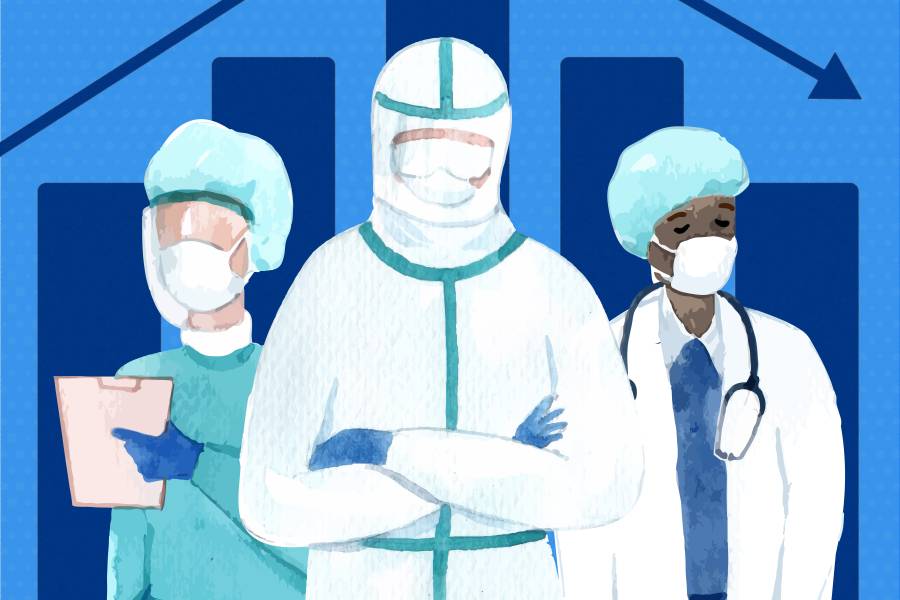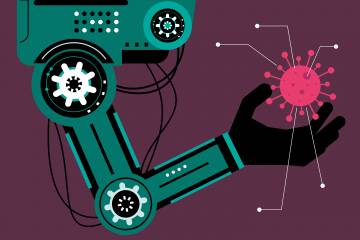Johns Hopkins physician Brian Garibaldi remembers that heartbreaking day in the ICU this winter when the walls went up again. "We'd just recently taken down the temporary walls that had turned it into a COVID ICU and we had to put them back," he says. "Seeing those walls go back up was pretty rough for all of us."
The short-lived COVID-19 respite, followed by omicron's furious spread, is a tragic reminder of the roller coaster nature of this pandemic, now entering its third year. Every time health care professionals dared to hope the worst was over, the virus evolved and struck again. The most recent surge delivered a powerful punch to hospital capacity, not just at Hopkins and in the state but in health systems across the nation.
"We've simply never seen this many COVID patients," says Gabor David Kelen, director of the Department of Emergency Medicine and director of the Johns Hopkins Office of Critical Event Preparedness and Response. "During the first surge, when this started, Maryland reached 1,500 COVID patients hospitalized at one time. This time, the state peaked at 3,462. We were snowed in during the second major wave, and now, with omicron, it's been nearly twice that. Think of a train wreck every day for weeks on end. That's what we are dealing with."
While there now are signs that omicron may be peaking in some parts of the country, hospitalizations nevertheless have broken daily records in recent weeks and cases and deaths continue to rise in regions where omicron had a late start. Maryland remains under a state of emergency, imposed Jan. 4 by Gov. Larry Hogan, and odds are that life will not return to normal any time soon.
"I've been wrong so many times trying to predict what's going to happen that I no longer try," says Garibaldi, director of the Biocontainment Unit and associate professor of medicine in the Johns Hopkins School of Medicine. "All I can say is that I expect we will still be very busy for the next few weeks. The sheer magnitude has been challenging."
The latest surge has, in fact, seen the largest increase of COVID-19-related admissions since the pandemic began. This is compounded by many staff members themselves becoming ill. "They're not getting it from the hospital but out in the community because COVID is everywhere right now," Garibaldi says. "On any given day, we have hundreds calling in sick. That puts an unbelievable stress on a system already operating short-staffed."
To be sure, this wave is different. Many COVID-19 patients are not as severely ill as those hospitalized earlier in the pandemic, thanks to vaccinations and boosters, and physicians know more now about how to treat COVID-19. Nevertheless, the sheer volume of patients has proved daunting. "Even though there is a smaller proportion of people with COVID who are very sick, it's still a huge number," Kelen says. "We are seeing a fair number of breakthrough infections, less so among the boosted. The vast number of people in the ICU or those intubated are unvaccinated, which, of course, is a double tragedy."
Those unvaccinated sick, he adds, frequently spurn vaccines even after recovering from their own infections. "They don't seem to be aware that they can be a lethal weapon to others themselves," Kelen says. "The anti-vaccine people have really dug in. It's hard to say whether this latest wave could have been prevented, but if more people in the U.S. had been vaccinated, I think it might have been more like influenza. All of the transmissions would not have been this bad, not even close."
Also see
To manage the overwhelming burden of current COVID-19 patients, Hopkins hospitals have converted regular rooms into negative pressure "bio-mode" status, an infection control measure that ensures that clean air flows in but infected air doesn't flow out so patients can be safely isolated. Elective surgeries have been put on hold, and hospital personnel have had to juggle space to accommodate non-COVID-19 patients who require ICU care.
Moreover, as every patient is tested, nearly a third of those hospitalized for other reasons—giving birth, heart attacks, broken bones, for example—have tested positive for the virus. Many are asymptomatic and unaware they are infected.
"This makes everything we do in the hospital a little tricky," says William Garneau, assistant professor of medicine. "It's like doing everything with your left hand when you're normally right-handed. Everything from getting blood drawn to a CT scan and delivering food trays has to be done in a special way to protect others."
Many administrative staff have set aside their nonpriority duties to volunteer in other departments. They are serving as hospital "runners" to the lab, pharmacy, and linen and supply departments, for example, spending 4-, 8-, or 12-hour shifts each week, around the clock, to support the clinical team. About 40 members of the National Guard arrived on campus earlier in January to help with testing operations and traffic control and other nonpatient tasks at Johns Hopkins Hospital and Johns Hopkins Bayview Medical Center.
Hopkins scientists also are using data to inform their decision-making. They have developed computer-based tools (in addition to the immensely popular COVID-19 tracker dashboard on the university's Coronavirus Resource Center website) that generate information that could make it easier for the public, policymakers, and hospital administrators to better handle the problems they face.
To ease the nationwide capacity crunch, for example, the Whiting School of Engineering has designed a site predicting when and where hospital beds will be available. Kimia Ghobadi, an assistant professor in the engineering school's Department of Civil and Systems Engineering, compares it to a grocery store checkout line, where customers often head for the nearest cashier. "That's how people go to hospitals," says Ghobadi, also associate director of the engineering school's Center for Systems Science and Engineering and among the faculty chairs of JHU's Malone Center for Engineering in Healthcare. "But the cashier isn't always able to handle a lot of people. The same is true for hospitals. This system helps overburdened doctors and nurses avoid patient transfers as a last resort, and patients will get a bed faster."
In another example, the Coronavirus Resource Center provides weekly data on hospitalization, both nationwide and in individual states, and also hosts regular 30-minute live briefings on Fridays, either weekly or biweekly, to provide COVID-19 updates. Anyone can link in. "We have a ton of traffic," says Beth Blauer, data lead for the center. "Much of the time it's people just trying to navigate their lives, getting a sense of what is happening with COVID in their community, and that is driving their own personal decisions."
Meanwhile, within the Hopkins hospitals—where fatigue and burnout remain a serious concern—physicians, nurses, staff, and other personnel have created their own ways of dealing with the unrelenting stress. At least two high-ranking hospital executives, for example, are volunteering on the COVID-19 wards. Their willingness to pitch in sends a strong message, Kelen says.
"Everyone is tired and dispirited, since all of this really grinds you down," he says. "So it really helps morale to know leaders are engaged and care enough to roll up their sleeves and go to work. It's tremendously appreciated."
Garibaldi also recalls how the ICU staff—doctors, nurses, respiratory therapists, and others—decided to deliver some holiday cheer to the unit on Christmas Day by caroling as they made their rounds. "We asked every patient to choose a Christmas carol," Garibaldi says. "We sang the carols they wanted to hear. If they couldn't speak, we asked a nurse to pick for them. If the nurse didn't pick, we sang the 'Grinch' song. It was great for us and for the patients. It was a way for everyone to remember that the ICU is a big family working together—and that we are going to get through this."
Posted in Health
Tagged coronavirus, covid-19, covid-19 variants










